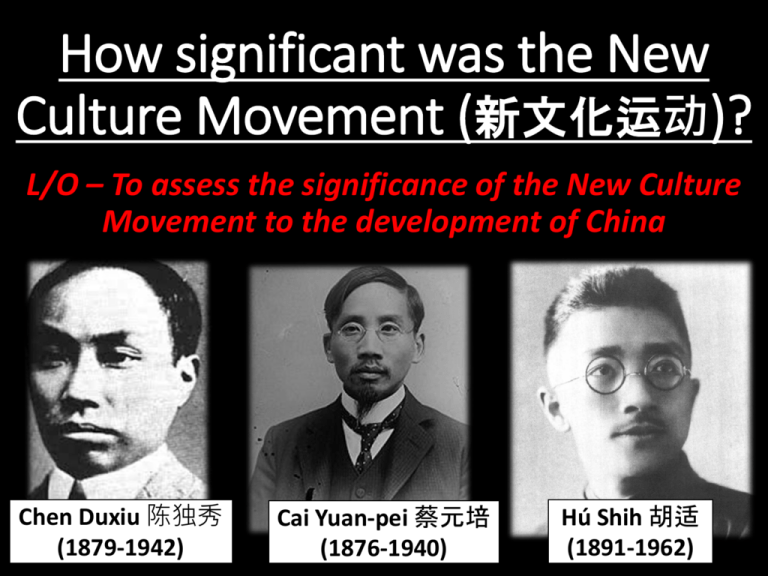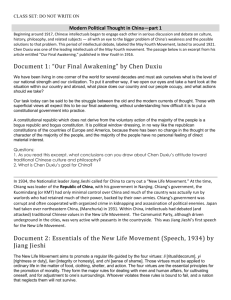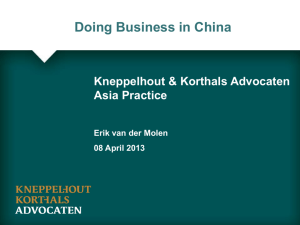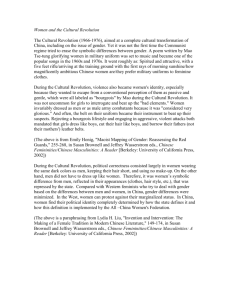How significant was the New Culture Movement?
advertisement

How significant was the New Culture Movement (新文化运动)? L/O – To assess the significance of the New Culture Movement to the development of China Chen Duxiu 陈独秀 (1879-1942) Cai Yuan-pei 蔡元培 (1876-1940) Hú Shih 胡适 (1891-1962) What was the New Culture Movement? • An intellectual revolution that changed the way that Chinese culture saw itself. • Its proponents attempted to radically change the ‘thought base’ of society in order to successful modernise China. • Its focus was on introducing Western Thought by destroying Cultural Traditionalism and Confucianism. • Some have called it the most drastic social and intellectual change in Chinese history, even a ‘Chinese Renaissance’. What was the New Culture Movement? • Many historians like C.Y. Hsü (2000) view the New Culture Movement as the third stage of China’s response to Western Impact: • Stage 1: Self-Strengthening Movement (1861-1895) – Superficial attempts at diplomatic and military modernisation • Stage 2: Reform and Revolution (1898-1912) – Acceptance of Western Political and Educational Institutions • Stage 3: Intellectual Awakening (1917-1923) – A further shift away from traditional Chinese base towards complete Westernisation Who were the key intellectuals? • Chen Duxiu 陈独秀 (1879-1942) – from Anhwei, trained in Chinese classical studies, passed the Qing civil service exam in 1896. Studied in Japan 1902-06 then moved to France in 1907, becoming heavily influence by Western philosophy. • He returned home in 1910 and participated in the 1911 Revolution. Fled to Japan after the second revolution in 1913. Returned in 1915 in protest at the 21-Demands, founding the magazine ‘New Youth’. He would later become the founding father of the Chinese Communist Party. Who were the key intellectuals? • Cai Yuan-pei 蔡元培 (1876-1940) – from Chekiang, won second & third degrees and member of the Hanlin academy. Studied in Germany, returning home in 1911. Minister of Education in Dr. Sun’s government, resigning when Yuan Shikai took the Presidency. • Went to Germany and France in 1912, returning in 1916 to take up the Chancellorship of the National University of Peking, reforming the institution into an intellectual powerhouse. Who were the key intellectuals? • Hú Shih 胡适 (1891-1962) – had a classical training and studied in the USA from 1909, earning a BA and PhD in Philosophy from Cornell and Columbia. • Returned home in 1917 and was appointed as Professor of Literature at National University of Peking by Cai Yuan-pei. • Hú was heavily influenced by the philosophy of pragmatism, scientific methods of thought and the evolutionary improvement of society. Initiated the movement for the vernacular use of Chinese (pai-hua) in literature. What were the long-term causes? 1. Impact of Western Ideas – Chinese intellectuals had studied Nationalism, Democracy, Liberalism, Socialism, Pragmatism and Scientific Methods in Western countries – all created a desire for reform. 2. New Politically-Conscious Classes – A rising merchant-entrepreneur class had emerged since 1912 and the economic boom in China during the First World War fostered their growing strength – they were often educated abroad, strongly nationalistic and benefited from reforms. What were the short-term causes? 3. Failure of the 1911 Revolution – Yuan Shikai’s betrayal of republicanism, attempts at re-instating the Monarchy and Confucian system and descent into Warlordism – angered intellectuals and progressives. 4. Japan’s 21-Demands – Yuan Shikai’s humiliating acceptance of the 21-Demands in 1915 sparked fears of imminent extinction and an outburst of nationalism Students returned home to protest, merchants organised boycotts of Japanese goods and a ‘new culture movement’ was started by a group of prominent intellectuals. Events of the New Culture Movement • The movement began as an intellectual response to recent events in China. The 21Demands of 1915 sparked an outpouring of anger and a desire to radically reform China. • From 1915, key intellectuals returned home and called for a critical re-evaluation of Chinese culture and heritage – the Confucian system was seen as the primary factor blocking reforms. • They called for the complete introduction of Western thought and ideas, which transformed the literary and intellectual personality of China. Chen Duxiu and New Youth Magazine • Chen (陈独秀) was first to return home in 1915, founding the magazine ‘New Youth’ (新青年) in Shanghai. • His editorial aim was to rouse the youth of China to destroy old traditions and achieve a national ‘awakening’. • Chen was particularly against Confucianism. He saw it as a product of an agrarian and feudal society, at odds with the modern world. China had to destroy it or the country would be eliminate by natural selection! ‘We indeed do not know which of our traditional institutions may be fit for survival in the modern world. I would rather see the ruin of our traditional “national quintessence” than have our race of the present and future extinguished because of its unfitness for survival… The world continually progresses and will not stop. All those who cannot change themselves and keep pace with it are unfit for survival and will be eliminated by the process of natural selection. Therefore, what is the good of conservatism?’ Chen Duxiu in Chow, Tse-tsung. The May Fourth Movement: Intellectual Revolution in Modern China. Cambridge, Mass, 1960, 46. Chen Duxiu and New Youth Magazine • He criticised Confucianism in particular because it was seen as the root problem afflicting Chinese culture: 1. It advocated ‘superfluous ceremonies and preached a morality of meek compliance’. 2. It recognised the family and not the individual as the basic unit of society. 3. It upheld the inequality of the status of individuals. 4. Stressed filial piety which made men subservient and dependent. 5. Preached an orthodoxy of thought in total disregard to freedom of thought and expression. Chen Duxiu and New Youth Magazine • Articles in the magazine were written to oppose conservatism and traditionalism in China. Instead, it asked the youth to choose fresh, vital elements from all the civilisations of the world. Its guiding principles were: 1. 2. 3. 4. 5. 6. To be independent and not servile To be progressive and not conservative To be aggressive and not retrogressive To be cosmopolitan and not isolationist To be utilitarian and not impractical To be scientific and not visionary Chen Duxiu and New Youth Magazine • The magazine was hugely popular, influencing and guiding a new culture of intellectual thought. • It inspired other intellectuals to found magazines like Peking University students who created ‘New Tide’ (Xinchao) in 1918 and ‘Weekly Critic’ (Mei-hou p’ing-lun). • The significance of these publications was in the fact that for the first time, they encouraged national and social problems to be openly debated in public. ‘There is an eager thirst for ideas – beyond anything existing, I am convinced, in the youth of any other country on earth’ American philosopher John Dewey on visiting China between 1919-1921 Cai Yuan-pei & National University of Peking • Cai Yuan-pei (蔡元培) became Chancellor of the National University of Peking (Peita) in 1916. • It was a corrupt and conservative institution. Professors were mostly government officials and a degree was seen as a stepping stone into officialdom. • Cai worked immediately to turn the university into an efficient and forward thinking institution. Cai Yuan-pei & National University of Peking • Cai set down three principles of administration for the institution: 1. Re-evaluation of national culture by scientific methods of research 2. A university education was not a substitute for the old civil service exams 3. Absolute academic freedom would be allowed, freedom of expression and rational thought encouraged. Cai Yuan-pei & National University of Peking • Cai’s changes transformed the university. It soon became the heart of the New Culture Movement. Scholars flocked to join the staff. Chen Duxiu • Chen Duxiu was made Dean of the School of Letters and Hú Shih was made Professor of Literature in 1917. Lǐ Dàzhāo (李大钊) was another radical who was made Head Librarian. His assistant was Mao Zedong (毛泽东)! • It was at the university that the direction of the New Culture Movement was shaped and debated. Li Dazhao Mao Zedong Hú Shih – Pragmatism and Plain Language • Hú Shih’s (胡适) contributions to the New Culture Movement revolved around the promotion of Chinese liberalism and language reform. • Influenced by the American John Dewey, Hú advocated the idea of pragmatism (实验主义) as a philosophy to evaluate traditional ethics and ideas, rather than simply destroying all traditional values. • He preached gradual, bit-by-bit improvements of society through studying its problems and experimentation. He was opposed to completely revolutionary ideas. John Dewey Hú Shih Hú Shih – Pragmatism and Plain Language • Despite his pragmatism, Hú was opposed to Confucianism, coining the phrase: ‘Confucius and Sons Incorporated’. • He wrote many articles on the topic for New Youth magazine, ranging from literature and history to textual criticism and pedagogy – all urged a re-evaluation of traditions. • He argued that Confucianism viewed the idea of truth as eternal and unchangeable – it was therefore out of touch with the realities of the modern world. • He argued: ‘Truth is changeable according to its utility based on experimentation’. Hú Shih – Pragmatism and Plain Language • Hú has mostly been remembered for his campaign to replace classical Chinese characters with a simplified, vernacular language (白话/pai-hua) – making Chinese easier to read for the ordinary person. Other famous writers include: Mao Dun, Lao She, Bing Xin and Lu Xun (鲁迅). Lu Xun’s essays and • He argued that traditional Chinese language fiction was elitist and dead – ‘A dead language could condemned not produce a living literature’ Confucian culture. See ‘Diary of a Madman’ • These changes revolutionised literature and literacy in China with the government (狂人日记) adopting the vernacular in all schools in 1920. and ‘The True Historian John Fairbank argued that the Story of Ah Q’ ‘tyranny of the classics had been broken’. (阿Q正传) The May 4th Demonstrations (五四运动) • These new tensions in society exploded on May 4th 1919. On 28th April, the Paris Peace Conference in Versailles ruled that the province of Shandong (山东) should be given over to Japanese control. • China had declared war on Germany in 1917, in the hope of regaining the province. Despite promises of ‘selfdetermination’ by US President Woodrow Wilson, the conference decided to give Shandong to Japan. The May 4th Demonstrations (五四运动) • Japan had first extended its control over Shandong during WW1. The 21-Demands of 1915, agreed to by Yüan Shikai (洪宪皇帝), gave Japan economic rights in the province. • In 1917, Japan signed agreements with Russia and Britain, gaining international acceptance for the 21-Demands. • In September 1918, the Chinese warlord government signed a secret deal with Japan. China received a 20 million Yen loan in return for Japan being allowed to station troops and build railways across the province. Japanese Prime Minister Okuma Shigenobu, whose government drafted the 21-Demands The May 4th Demonstrations (五四运动) • These agreements isolated China at the Conference, resulting in Japan receiving the province. • This left Chinese faith in the West shattered. It was a national humiliation. • When the news was received in Peking, a crowd of over 5000 students organised a mass protest. Telegrams were sent to the Chinese Delegation in Paris, urging them to refuse to sign the Peace Treaty. The May 4th Demonstrations (五四运动) • Some protesters were arrested. In response, a general strike was called by all students. • The strike soon spread to other major cities – shopkeepers, industrial workers and commercial employees all joined the strike. • A nationwide boycott of Japanese goods was urged, and dockhands refused to unload Japanese ships. The May 4th Demonstrations (五四运动) • The government was shocked. Under pressure and facing economic collapse, it dismissed the pro-Japanese members of government including – Cao Rulin (曹汝 霖) who had signed the 21-Demands. • It instructed the delegation in Paris to make its own decision – it eventually refused to sign the peace treaty. • The May 4th Demonstrations served as a ‘catalyst’ for the intellectual revolution, intensifying debate and leading to a split in the movement. Cao Rulin Splits in the New Culture Movement • The May 4th demonstrations led to a reevaluation of the New Culture Movement. The Paris Peace Conference was viewed as a betrayal of China by the West. • Some intellectuals began to question the utility of Western Ideas and looked to other models of developments like Marxism, Bolshevism and Anarchism. • Others sought a return to traditional Chinese Spiritualism whereas some argued that Western Ideas were still the best – despite the failure of liberalism at the Paris Peace Conference. Splits in the New Culture Movement • The split in the intellectual movement was between those that favoured ‘gradual social reforms’ vs those that wanted ‘rapid fundamental changes’. Hú Shih • Hú Shih, a pragmatist, cautioned against talk of ‘isms’ and wanted people to study problems rationally – ‘Drop-by-drop improvements’. Hú would later support the Kuomintang. Chen Duxiu • Chen Duxiu & Li Dazhao said ‘isms’ were necessary to give direction and solve social problems. They would both go on to establish the Chinese Communist Party. Li Dazhao Conclusion – Significance of N.C.M • The New Culture Movement fundamentally changed the intellectual and culture discourse of Chinese society. • It introduced Western ideas and brought China into the modern world. Hú Shih • May 4th led to a split in the movement. Debate focused on which path of Western development would be best for China. • Some like Hú Shih, preferred liberalism and gradual improvements. Others, like Chen Duxiu, advocated Marxism and revolutionary change. Chen Duxiu Conclusion – Significance of N.C.M • These debates led to the establishment the Chinese Communist Party in 1921 by Chen Duxiu and Li Dazhao. • Hú and the more pragmatic reforms retreated into academic study but would support the approach of the Kuomintang in developing China gradually. • The New Culture Movement thus defined the intellectual discourse of China until the Communist victory of 1949. Even today, debate rages over the benefits and nature of the movement. Hú Shih Chen Duxiu Conclusion – Significance of N.C.M • Liberals = viewed the movement as one of emancipation from old thought, old ethics, old values and was an affirmation of human rights. It was a ‘Chinese Renaissance’. • Conservatives = viewed the movement as a corrupting influence on the youth, lacking respect for traditionalism. But was useful for stimulating nationalism. • Radicals = like Marxists viewed the movement as one of ‘human liberation’. It was an anti-imperialist and anti-feudal bourgeois-democratic revolution. Helped the proletariat gain their independence and consciousness. Conclusion – Achievements of N.C.M 1. Literary Revolution – Introduction of plain language in 1920 and new literature based on humanitarianism, feminism, romanticism, realism and nationalism. Instilled a social consciousness in the public – ‘literary revolution to revolutionary literature’ 2. Acceptance of Foreign Ideas – Western ideas became embedded in Chinese culture, taking on a dynamic of their own, resulting in new ideologies like Chinese Communism. Conclusion – Achievements of N.C.M 3. Intensification of Nationalism – The movement stimulated the rise of a ‘Young China’. National confidence rose as people underwent ‘psychological reconstruction’. It sparked a new awareness in the condition of China and a violent reaction against foreign imperialism. 4. Destruction of Confucianism – No other event, including the 1911 revolution, managed to deconstruct traditional systems of belief in China as much as the New Culture Movement. In this sense, it was a ‘renaissance’. Was the New Culture Movement a ‘revolution’? • Whilst the New Culture Movement did create huge changes in intellectual thought, it didn’t immediately change the socio-political realities of life in China. • It stirred up debates and problems without creating lasting solutions or a new culture for everyone. China was stilled ruled by warlords and a government who remained unaffected by the changes and who held the keys to power. • The key question for reformers was now what direction would China take? Would it pursue evolutionary or revolutionary change? And how could it defeat the warlords to enact these changes? Paper 3 - Exam Question 1 (2013) • To what extent was the New Culture Movement (19151924), which included the 1919 May Fourth Movement, an intellectual revolution that changed the course of Chinese politics? (20 marks) The events following the 1911 Revolution saw the establishment of the Republic followed by its betrayal by Yuan Shikai (Yuan Shih-k’ai). This was a change of regime, but not a change in political or cultural attitudes. Candidates may first identify what they consider to be the events relating to the New Culture Movement. These could include: weak central government; Japan’s 21 Demands in 1915; warlordism after the death of Yuan Shikai (Yuan Shih-k’ai) in 1916; China’s relationship with the West during the First World War; the May Fourth Movement which began as an outburst by workers and students in response to China’s treatment in the 1919 Treaty of Versailles. However, once the context has been established candidates will need to analyse some of the ideas embodied in the New Culture Movement in order to fully answer the question. Intellectuals from Beijing University, such as Cai Yuanpei (T’sai Yuan-p’ei), Hu Shi, Chen Duxiu (Ch’en Tu-hsiu), Li Dazhao (Li T-chao) and Lu Xun (Lu Hsun), were heavily involved in the New Culture Movement. It was an intellectual revolution and literary revival which promoted the publication of magazines in the everyday language and characters. Chen Duxiu’s (Ch’en Tu-hsiu’s) New Youth magazine and the other New Culture Movement publications favoured Western ideas such an emphasis on youth, liberalism, democracy, socialism and Marxism. They criticized China’s traditional society and Confucian values and promoted Western science and scholarship. The New Culture Movement aimed to develop a new cultural identity for China. The May Fourth Movement was a political response to the Treaty of Versailles that was anti-imperialist, patriotic, favoured student and worker involvement in politics and the establishment of unions. It was an urban political movement that was against the warlordism rife in China and favoured national unity. The May Fourth Movement arose in the context of the New Culture Movement, but the terms are often used interchangeably to mean the whole intellectual revolution. Some candidates may argue that the New Culture Movement/May Fourth Movement destroyed traditional Chinese values and society and that Western political and cultural ideas dominated without much constructive gain. Other candidates may argue that the course of China politics was changed by the New Culture Movement/May Fourth Movement in that this intellectual milieu gave rise to the Chinese Communist Party in 1921 and Sun Yixian’s (Sun Yat-sen’s) revamped Guomindang (Kuomintang) in 1924. Although, in 1924 the First United Front between these parties was created, the next twenty-five years was characterised by the conflict between them. Answers that merely describe the 1919 May Fourth Movement without reference to the intellectual ideas embodied in the New Culture Movement cannot score highly. Paper 3 - Exam Question 2 (2010) • To what extent was the May Fourth Movement (1919) significant in determining the future of China? (20 marks) The events following the 1911 Revolution saw the establishment of the Republic followed by its betrayal by Yuan Shikai (Yuan Shih-k’ai). This was a change of regime, but not a change in political culture. The 1919 May Fourth Movement saw a new type of political activism and gave its name to an intellectual, cultural and political movement, which lasted into the 1920s and beyond. Politically, expect reference to student demonstrations, opposition to the Treaty of Versailles, the impact of the Russian Revolution and Communist ideology, the creation of the Chinese Communist Party and Sun’s reform of the Guomindang (Kuomintang). Intellectually, “destroying the past” included the rejection of Confucianism, the debate between science and metaphysics, the vernacular language movement and the emergence of writers like Lu Xun (Lu Hsun). Candidates will need to analyse some of the ideas embodied in the May Fourth Movement in order to fully answer the question. The May Fourth Movement was a part of the wider New Culture Movement, an intellectual revolution and literary revival which promoted the publication of magazines in the everyday language and characters. It favoured Western ideas such as an emphasis on youth, liberalism and socialism and it criticized China’s traditional society and Confucian values. The May Fourth Movement was also anti-imperialist, patriotic, favoured student and worker involvement in politics and the establishment of unions. Candidates must address “the past” in their evaluation. Some may argue that the act of creating a republic may not have had the immediate effects in “constructing the future” that had been hoped, but that the foundations had been laid for what was to follow. Others may see the real renaissance of China as stemming from the events of the May Fourth movement in 1919 and the intellectual and cultural renaissance it came to represent. Some candidates may argue that traditional Chinese values and society were destroyed and Western political ideas dominated without much constructive gain. Other candidates may argue that the future directions of China were set by the May Fourth Movement. Give credit to candidates who trace the significance forward, and expect evaluation in the context of developments in China as far as at least the 1930s. Some candidates may go as far as 1949 so credit relevant analysis and comment. Paper 3 - Exam Question 3 (2007) • “May 4th 1919 is a more significant date in Chinese history than October 10th 1911.” How far do you agree with this statement? (20 marks) The events following October 10th 1911 saw the overthrow of the Qing (Ch’ing) and the establishment of the Republic, which was followed by its betrayal by Yuan Shikai (Yuan Shih-kai). There was a change of regime, but not a change in political culture. May 4th 1919 saw a new type of political activism and gave its name to an intellectual, cultural and political movement, which may be dated back to the founding of New Youth in 1915 and lasted into the early 1920s. Politically, expect reference to student demonstrations, opposition to the Treaty of Versailles, the impact of the Russian Revolution and Communist ideology, the creation of the Chinese Communist Party and Sun’s reform of the Guomindang (Kuomintang). Intellectually, it included the rejection of Confucianism, the debate between science and metaphysics, the vernacular language movement and emergence of writers like Lu Hsun (Chou Shu-jen). Credit candidates who argue for either date. Some may argue that the act of creating a republic may not have had the immediate effects hoped, but that doing so lay the foundation for what was to follow. Others may see the real change as stemming from the events of May 4th 1919 and the intellectual and cultural renaissance it came to represent. [0 to 7 marks] for an account of events only. [8 to 10 marks] for accounts which provide a clear description of events associated with the two dates with some attempt to suggest which was the more significant. [11 to 13 marks] for attempts to provide an analysis of the two events and their significance. [14 to 16 marks] for a more detailed comparative analysis of both events in their political, cultural and intellectual context. [17+ marks] for well-structured comparative analysis which reaches a clear conclusion supported by historical evidence.







